This May, we’re taking a look at the fourth (and final) season of Star Trek: Enterprise. Check back daily for the latest review.
Discussions of the fourth season of Star Trek: Enterprise tend to focus on the multi-part episodes.
That makes a great deal of sense. After all, no Star Trek show had ever built a season around a collection of multi-part arcs. While Star Trek: Deep Space Nine had embraced serialisation in the second half of its run and Star Trek: Voyager had embraced an aesthetic that supported two-part “event” episodes, there had never been a season of the franchise constructed around a string of two- or three-part adventures. Even the third season of Enterprise had really been on long form story with the occasional episodic diversion.

Padding it out.
These multi-part stories dominate the fourth season. Of the twenty-two episodes of the fourth season, seventeen are part of seven multi-part stories. Of the five episodes that nominally stand alone, Home is very much a thematic introduction to the season that sets up all manner of ideas to pay off later in the run and These Are the Voyages… is effectively an attempt at a coda for the eighteen years (and twenty-five television seasons) of the Berman era as a whole. Discounting these two “bookends”, that leaves only three standalone episodes.
Two of those episodes, Daedalus and Observer Effect aired back to back in the middle of the season. However, although each episode is self-contained in terms of plot, they do feel like spiritual companion pieces.

Turn the lights off on the way out…
Daedalus and Observer Effect aired in January 2005, although they would have been produced before the Christmas hiatus. In particular, Judith and Garfield Reeve-Stevens have acknowledged that Observer Effect was written as part of a budget crunch in an effort to save money amid a run of “epic” multi-episode adventures that featured trips to Vulcan, Romulus and Andoria. These pragmatic demands were evidenced by the use of standing sets and the tight focus on the ensemble without a single supporting guest star.
Daedalus is quite similar in scope and tone. Much like Observer Effect, it is a bottle show that is shot primarily on standing sets. Daedalus is clearly the more expensive episode of the two; it features two major supporting roles for Bill Cobbs and Leslie Silva, along with two minor supporting roles for Donovan Knowles and Noel Manzano. The episode also heavily features a special effect, as Enterprise is “haunted” by the ghost of Quinn Erickson, a soul long lost in the transporter.

Lost in space.
Even allowing for all of this, Daedalus is still very clearly an episode designed to save on the production budget. It lacks the location work of The Forge and the expansive supporting cast (or special effects work) of Awakening and Kir’Shara. It does not feature the expansive prosthetics work of Babel One, the CGI spectacle of United or the elaborate sets of The Aenar. It is, in Star Trek terms, a relatively quiet bottle show that the production team could turn out on budget and on schedule. As such, it fits quite comfortably alongside Observer Effect.
Even though Daedalus is technically a standalone episode, the story still ties quite firmly into the continuity of the fourth season around it. Although the fourth season had abandoned the season-long arc that drove the third season, there is still a strong sense of continuity between individual episodes. Stories might tidily wrap up over the course of one to three episodes, but the show repeatedly assures the viewer that those events still inform character interactions and dynamics.
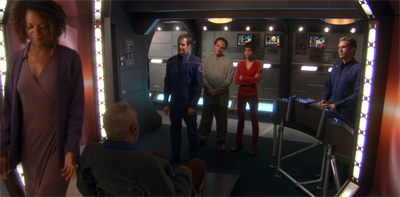
Next transport of call.
For example, Daedalus devotes considerable time and effort to building off the events of The Forge, Awakening and Kir’Shara, particularly as they apply to T’Pol. T’Pol is reading the Kir’Shara that had been recovered by Archer in Awakening and presented to the Vulcan people in Kir’Shara. Phlox confirms that T’Pau’s mind meld with T’Pol in Kir’Shara successfully cured her Pa’nar Syndrome, putting Enterprise in the awkward position of paying more attention to the curing of T’Pol’s illness than to the illness itself.
Daedalus devotes an entire subplot to T’Pol working through the consequences of the last arc, which is not a bad idea in theory. Although mainstream television embraced serialisation more tentatively than cable programming, one of the subtle ways that serialisation crept into a episodic storytelling towards the end of the nineties and into the new millennium was a willingness to allow characters to unpack and process particularly traumatic events in a way that had not traditionally been done in the episodic model.

Reading a good book.
Perhaps even THE good book.
(It is interesting to wonder whether this trend was merely a logical development of an evolving storytelling aesthetic, or if it was tied into a broader cultural movement. After all, trauma was very much a part of the American consciousness in the early years of the twentieth century, with a renewed focus on the idea of unintended consequences or the difficulty of living with horrific events. There is a very clear post-traumatic tone bubbling through twenty-first century popular culture, one that is quite evident within Enterprise itself.)
So Daedalus devotes a subplot to T’Pol working through the death of her mother in Awakening and the dissolution of her marriage in Kir’Shara. While it is a good idea in principle, there is something very insubstantial about the plot. It is nice to acknowledge past events, but nothing really happens. The biggest character beats concern the relationship between Trip and T’Pol that the show had been teasing since Harbinger, but Daedalus is frustratingly non-committal on the subject.
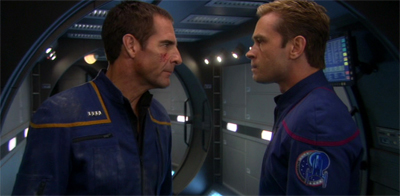
“Well, it’s this or Bound.”
Of course, this is all in service of later developments like Trip’s reassignment to the Columbia in Affliction and their cloned baby in Demons, but here it just feels like stalling and padding. In some respects, the T’Pol subplot in Daedalus serves as a warning about the potential pit falls of serialisation, of the way it can feel like spinning wheels. Truth be told, the biggest issue with the subplot is how much time is devoted to it. In theory, the commitment to long-form plotting is commendable.
It does not help matters that the primary plot of Daedalus is so lifeless and familiar. It is very much a stock mad scientist story, in which a famed inventor effectively commandeers the Enterprise for research work that ultimately goes horrible wrong as a result of a secret that the researcher chooses to conceal from the crew. Emory Erickson recalls Richard Daystrom from The Ultimate Computer or Kosinski from Where No One Had Gone Before. Inevitably, this research comes at a high cost to the crew, putting lives in jeopardy.

Tabling the matter for later.
Daedalus is still a fourth season episode, so it comes heavily tied to the framework of existing continuity. Emory Erickson is not just any mad scientist. He is the inventor of the transporter, a key piece of Star Trek lore. Producer Manny Coto points to this as the aspect that drew him to the story in the first place, an opportunity to fill in a continuity lacuna:
One of the ideas that I’ve had is, we’ve seen Zefram Cochrane, the originator of the warp drive. But we’ve never seen the individual who invented the transporter, which I think is as important an invention as the warp drive, when you really think about it. So I want to do a story about an individual who is kind of a Daystrom, if you remember the old series character [from the original series episode The Ultimate Computer], who’s invented the transporter, and a story about him.
Perhaps Daedalus serves as a lesson in the limitations of the fourth season’s approach to continuity. It is not enough for a story to have a connection to Star Trek lore. The story needs to function on its own terms. “Let’s meet the inventor of the transporter” is an interesting idea, but it is not strong enough to support a story. Emory Erickson never feels as important as Zephram Cochrane because he never gets a story as good as Metamorphosis or Star Trek: First Contact.

“Okay, but I better get a really good role in the series finale.”
There is a sense that Star Trek really doesn’t need an origin story for the transporter. After all, as much as the transporter has become an iconic part of the franchise, it is also a very practical element. The transporter was not an essential ingredient of Gene Roddenberry’s original vision for the show. It was not something that was baked into the original premise. The transporter was instead created as a matter of expedience, a storytelling necessity rather than a conscious narrative choice.
After all, production realities made it impossible and impractical for every episode of Star Trek to feature Kirk and Spock taking a shuttle down to a given planet. It would have only increased the budget on a show that was already expensive to produce and which already struggled to fit all the necessary plot into its allotted run-time. The transporter was very much a compromise; it was a way to get the characters to the heart of the action as quickly as possible without too much fuss.

Inventing the future.
David Gerrold acknowledges as much in The World of Star Trek, explaining how much of what would now be considered “world building” derived from the simple logical demands of this kind of storytelling:
“Well, I need a Captain and a spaceship and a crew. The spaceship should be able to travel faster than light so it can visit other planets, but it takes too much time and money to show it landing on a new planet every week, I need – yes, a transporter beam… and let’s see, we’ll need a big crew so we can tell stories about individuals aboard the ship . . .oh, now who sent him out? We ought to know what his orders are . . .” And so on.
While there is some pleasure to be had in reverse-engineering these concepts, it is easy to forget that much of the Star Trek universe derived from brilliant exhausted television writers trying to hit a deadline. Not everything needs a back story.
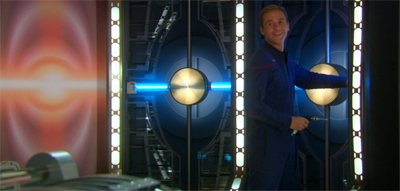
Talk about reverse engineering.
Erickson seems to acknowledge as much over dinner with Archer, delving into the sort of hypothetical metaphysical questions about the transporter that became popular with James Blish’s Spock Must Die! Erickson ponders “all that metaphysical chatter about whether or not the person who arrived after the transport was the same person who left, and not some weird copy.” That of itself is an interesting philosophical question, but hardly one to support forty minutes of television. Even allowing for that, Daedalus is much lighter still.
Bill Cobbs is a great actor, and it is great to incorporate him into the larger Star Trek mythos. However, Erickson never feels like a real character. Instead, he feels like an archetype. He is the classic Star Trek antagonist; the official with a secret, one who arrives on the ship and then obfuscates to cover his own agenda. Cobb is a phenomenal performer, but the material simply does not support him. Erickson feels like a collection of familiar beats (folksy, narcissistic, guilt-driven) rather than a fully-formed character in his own right.
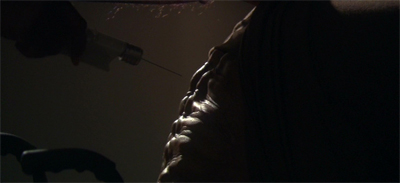
You can do it, put your back into it.
It is all very surface level. Indeed, the most interesting character detail of the entire episode is a brief shot of the scarred and distorted tissue on his back. Much like the quick shots of the bruises on Bruce Wayne’s back at the start of The Dark Knight, it is a very effective (and understated) way of signalling the pain that Erickson has endured in pursuit of his goals. However, none of the dialogue or conversations come close to matching the emotional power of that very simple image. Everything feels by the numbers.
Much like Observer Effect, this is very much Enterprise doing its riff on classic Star Trek concepts. It feels like a throwback to the second season, when it seemed like the show had devoted itself to generic reworkings of familiar premises. In fact, both Daedalus and Observer Effect play as copies of second season episodes that felt like copies themselves; Daedalus recalls Vanishing Point which recalls Realm of Fear, while Observer Effect evokes The Crossing which evokes Power Play and Lonely Among Us and Return to Tomorrow.
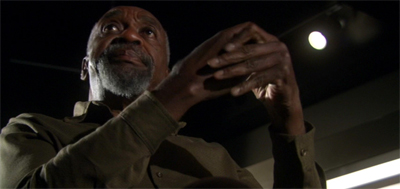
The Transporter.
However, the most damning comparison invited by Daedalus is the comparison to The Visitor. Both are stories about a family broken up by a science-fiction tragedy, with a particular emphasis on fathers and sons. Like Benjamin Sisko, Quinn Erickson finds himself trapped in a state on death, bouncing into and out of reality. Like Jake Sisko, Emory Erickson has become obsessed with resurrecting his long-lost family member at the cost of all else. Indeed, the two are finally reunited with the the death of the son.
The Visitor is one of the best episodes of Star Trek ever produced. It feels like a spectacular error in judgment for Daedalus to so blatantly evoke a classic episode, much like the way that Dawn suffered by consciously evoking Darmok. In some respects, Daedalus is a perfectly average episode. It is not racist like Extinction was nor sexist like Bound will be. Judged on its own merits, the worst that might be said of Daedalus is that it is familiar and (more than a little) dull. However, inviting comparisons to The Visitor… well, those comparisons are not complementary.
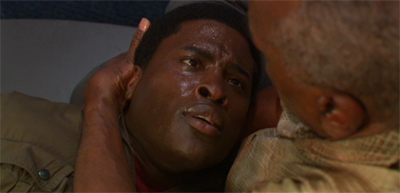
“To my son, who is coming home.”
To be fair, the production team seem ready and willing to acknowledge Daedalus as a misfire. Coto reflects on the season as a whole:
“For me, the less successful stories this year have been the stand-alone ones,” Coto told journalist Steve Eramo. “An episode that immediately comes to mind is Daedalus. I wasn’t pleased with the way the script turned out or with the final production. It was just a flawed episode. I think one of the things we discovered in the fourth season is that Star Trek, or at least Enterprise, worked best on a large canvas with large stories that took multiple episodes to tell.”
It is certainly any easy conclusion to draw. The fourth season’s standalones include Daedalus, Bound and These Are the Voyages… They are hard to defend.

Cheers for that.
However, it also seems reasonable to argue that the problem with Daedalus has nothing to do with the format or the scale. It is entirely possible to tell an effective story about a family separated for decades by Star Trek technology. The Visitor ably demonstrated that. The problem with Daedalus, Bound and These Are the Voyages… have nothing to do with the fact that that they were told over the space of a single episode. The problem is that the stories and scripts are uninspired. There is little to suggest that Daedalus or Bound would be stronger with a larger scale to it.
Daedalus is maelstrom of Star Trek clichés. It even features the death of a red shirt to escalate the threat when Reed and Burrows are attacked in the armoury. It is a very lazy way of raising tension, particularly given that Enterprise worked very hard to avoid that particular plot device during the first two seasons. (Although it could be argued that it leaned a little bit too far in the opposite direction, proving unwilling to kill any crew member or put the crew in obvious danger.) Daedalus is very much “Star Trek plotting by the numbers.”
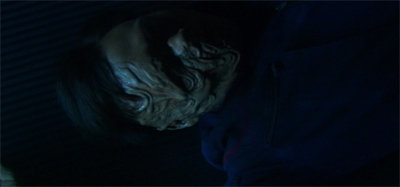
Burrows, we hardly knew ye.
This is particularly obvious at the climax, during the scene where Emory Erickson attempts to save his son. This should be a powerful and emotive moment, but it gets lost in a mess of awkward technobabble. “He’s losing cohesion,” Phlox insists. “If he materialises, he’ll die in seconds.” Erickson responds, “I can reverse the damage by cross-phasing the stream.” This is the scene that really needs to work. This is the scene where Erickson’s obsession comes to a head. This is a father reunited with the son he lost. But none of that lands because of focus on the technobabble.
Still, there are some interesting themes bubbling beneath the surface of Daedalus, themes that resonate and echo in Observer Effect. While both episodes are very simple “done in one” narratives, they both have a funereal atmosphere that seems to reflect the mood of the show around them. Both Daedalus and Observer Effect are stories about death and loss filtered through the lens of powerlessness. For a show that was staring down the barrel of the gun and facing its own cancellation, these were relevant themes.

Impressive handiwork
Even Erickson’s research is presented as an existential threat to the Enterprise and her mission. Erickson is essentially hoping to render Enterprise redundant and obsolete, a museum piece. He plans to advance transporter research to the point that starships become redundant. He threatens to bring about the end of Star Trek. Over dinner, Erickson ponders, “You tell me, with that kind of technology who’d have any use for a starship?” Archer responds, “Maybe you will put me out of a job.” Erickson argues, “Starfleet’s gonna look a hell of a lot different. That’s if it exists at all.”
(Once again, through synchronicity and coincidence, Star Trek Into Darkness looms large over the fourth season of Enterprise. Erickson’s discussion about long-range transporters and whether they render space travel redundant recall fan arguments about the contrivance of Khan’s long-range subspace transport to Qo’nos. It is a little detail, one that was most likely unintentional, but it does demonstrate how the fourth season of Enterprise seemed to summon the future, even as this iteration of the franchise was in its death throes.)
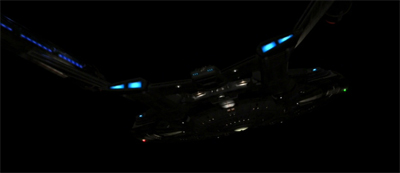
Into Darkness.
Daedalus finds Enterprise traveling through a region of space known as “the Barrens.” Archer describes it as a place where “there’s not a star system within a hundred light years.” Archer’s log entry is accompanied by the disconcerting visual of the Enterprise traveling through a starless sky, a grey ship against a black canvass. It is an image that recalls the claustrophobia of The Expanse, an episode that featured the ship wandering into uncharted territory with the stars obscured. Daedalus takes the crew to a place where the stars have gone out, where there can be no more Star Trek.
At its core, Daedalus is a horror story… a ghost story. It imagines the crew consigned to a black starless void. “There’s a reason this is called the Barrens, Captain,” Erickson assures Archer. “There’s nothing out here.” All that is missing is the soft sound of the hull creaking or that of an inexplicable cold breeze blowing gently through the ship. When Quinn shows up, he is presented as a ghostly apparition. He is a spectre haunting the crew. It feels like one of those urban legends of the space way that Mayweather discussed in Strange New World.

The shape of things to come.
On one level, this feels like a conscious throwback to the first season of Enterprise and the first season of Star Trek. Daedalus touches on that recurring sense of space as home to Lovecraftian horrors in episodes like The Man Trap, What Are Little Girls Made Of?, Catspaw, Wolf in the Fold, The Immunity Syndrome, Fight or Flight and Silent Enemy. However, it also seems like the honest reflection of a television series standing on the cusp of cancellation. Much like the Enterprise finds itself haunted and isolated in Daedalus, so does the show itself.
The script seems to acknowledge as much. At the climax of the story, it becomes clear that Emory Erickson will not be able to save Quinn, who has been lost for fourteen years. As with other dates in the fourth season, the chronology seems quite deliberate; fourteen years would take the Star Trek franchise back to the dawn of the Michael Piller era on Star Trek: The Next Generation, the point at which the second generation of Star Trek shows finally “clicked” and arguably established a template that endured for over a decade through all of Voyager and half of Enterprise.
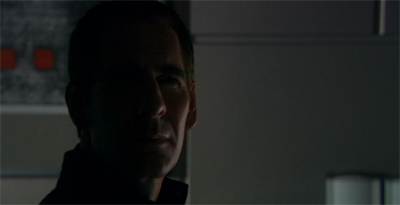
Afraid of the dark.
It is clear that Quinn cannot be saved. The best that can be done is put the poor soul out of his misery, to reunite him with his father and offer some sense of peace. “I couldn’t leave him like that,” observes Emory. “It’s better to be alive or dead, not somewhere in between.” The truth is that the fourth season of Enterprise exists “somewhere in between”, a dead show revived so that the episode count might inch closer to those required for syndication. Perhaps some of the production team might empathise with Emory, living the shadow of another cancellation.
There is perhaps some self-criticism buried in the episode. Emory is very much a flawed creator acknowledging the limitations of his work. Certainly, Trip comes to see Emory as a fallen hero, a legend with feet of clay. After all, Enterprise arrived at the tail end of a franchise that had been in decline since the peak of mid-nineties with the success of The Next Generation. “After an achievement of that magnitude, there was nowhere to go but down,” Emory confesses. “My life became just one long struggle to recapture past glory.”
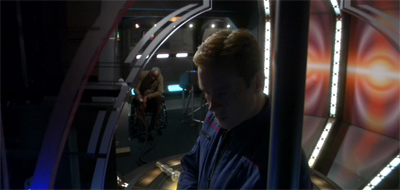
Taking it all apart.
Given how hard Voyager and Enterprise had struggled to emulate the success of The Next Generation, there is some grain of truth in all that. In its first two years, Enterprise often felt like a faded photocopy of a photocopy. It looked a lot like the “ghost” of Quinn Erickson, a blurry shape recognisable only in outline. So many of those first and second season episodes went through familiar plots and arcs, often emulating past successes. Ironically, Daedalus itself is one such example, owing as much as it does to better stories like Realm of Fear or Daedalus.
Of course, all of this is bubbling away beneath the surface of a fairly bland episode. As much as Daedalus might be a sad and strange little story about a life trapped in limbo, it is not a very good one.
Filed under: Enterprise | Tagged: Conditions and Diseases, Crete, Daedalus, David Gerrold, first contact, Health, icarus, Project Icarus, Sleep disorder, star trek, star trek: first contact, United States, World of Star Trek, Zefram Cochrane |




















Erickson’s first mistake was trying to save his son in an episode called “Daedalus,” which simply invites his son to play the part of Icarus. He should’ve tried to rescue him in “Fortunate Son.”
I actually never connected this episode to “The Visitor,” rather I thought it derivative of “Jetrel” – a guilt-ridden scientist secretly hopes to redeem his mistake using the transporter.
“Bill Cobbs is a great actor”
You might remember him as Zachary Lamb from Demolition Man, or “off-brand Morgan Freeman” in everything else ever made.
I feel kinda sad that his most recent work that I can remember is this and the Night at the Museum movies.
A note for trivia buffs. Cobb played the (effective) lead in The Others, a short-lived series with John Billingsley.
It’s a shame that these guys haven’t had the best roles. The acting business today is, pardon my language, a shit-show.
Because of JJ Abram’s zeal to make the movies “faster”, turbolift travel is instantaneous, transporters can transport to ships in warp light years away, and Khan can transport from the heart of the Federation, to the heart of the Klingon Empire in a few seconds. But of course, Starships will never be obsolete because how else can you have lasers shooting everywhere and explosions? You can’t have a Star Trek movie without that! It’s not like they’ll just build a transporter on Earth, which would use Scotty’s transwarp beaming to just beam all of the Federation’s enemies in the Alpha Quadrant into the sun, that’s not epic enough.
Agreeing with you once again 😛 Don’t really have anything to add, but you are pretty apt on how bad the Abram films are.